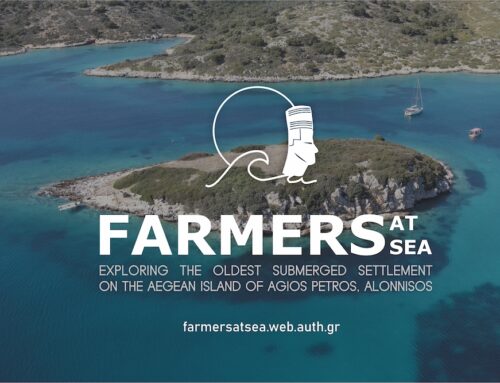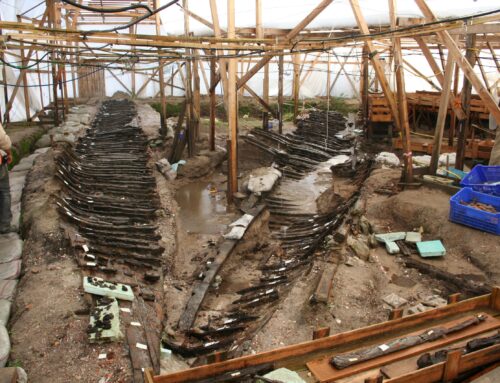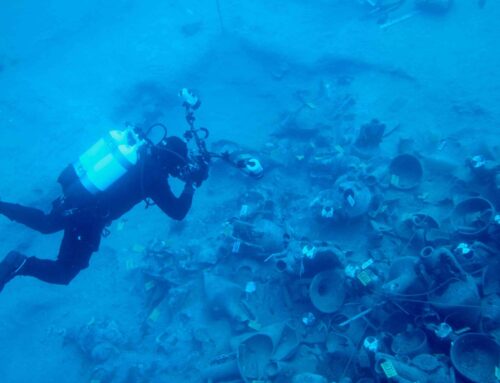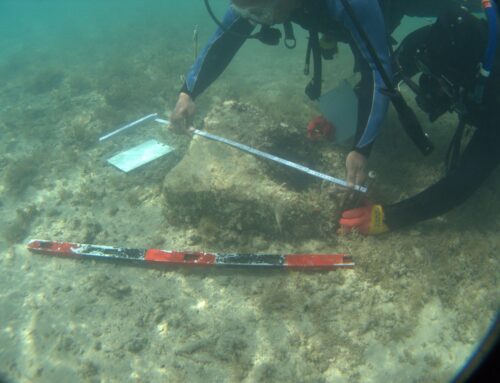Undiscovered Underwater Worlds
Dive & Dig Blog by Lauren Tidbury

Honor on the Marsala Punic Ship in 1971. (Image courtesy of the Honor Frost Archive, Special Collections, University of Southampton).
We are really excited to be launching the first episode of our Dive & Dig podcast, ‘Undiscovered Underwater Worlds’! Almost a year ago the Foundation began to think about how we could engage with a wider audience about underwater cultural heritage utilising the growing popularity of podcasts. Discussions began with a small team made up of Lucy Blue, Cathy Giangrande and myself, Lauren Tidbury. We discussed lots of ideas for a podcast series, and thankfully with Honor Frost’s career spanning over 50 years, alongside the many research projects supported by the Foundation, we weren’t short of material!
It was great fun reading back through Honor’s book Under the Mediterranean. I wish I could have been there in the 1950’s and 60’s, so many amazing adventures and stories to tell! We decided to focus our first episode on those early days of diving, exploring how Honor went from a set designer and illustrator, to become the first female underwater archaeologist! She beautifully explains her first experience of diving in her book;
“There were 6 metres of black water above my head and I sucked air through a mouthpiece, connected by hose to a pump on the surface …. A full moon shone on the snow-covered garden, but I was no longer conscious of that world. This first crazy experiment reduced the act of diving to its essentials. My mind was confused neither by exotic surroundings nor the beauties of subaqueous light and landscape, for the baptism took place in a well in Wimbledon”. (Frost, 1963:3)
As part of this episode we went on to explore how SCUBA (Self Contained Underwater Breathing Apparatus) developed and the impact that had on the field of maritime archaeology, so who better to explain this than Philippe Cousteau, grandson of Jacques Cousteau, the co-inventor of the aqua lung.
Philippe tells us about how just over 75 years ago his grandfather was testing a new device he co-invented to explore the ocean freely, his creation of a valve to regulate gases under pressure and convert them to ambient pressure on demand, was a simple innovation which opened up the underwater world. His grandfather had a passion for wrecks and history and recognised how intertwined our history is with the ocean, explaining how the ocean unites us, a crossroads of civilisation.
We also wanted to hear from someone who had dived with Honor in those earlier days, and we were lucky to be able to talk to Bob Yorke, who dived with Honor in the 1970’s off the coast of Sicily. Subsequently, she went on to discover the famous Marsala Punic Ship. Bob was diving in 1970 when they were searching for wrecks and talked to us about what these early days of archaeological diving were like. They undertook a systematic survey along the coast using a tape measure and line, searching for shipwrecks. They found five possible wreck sites and numerous artefacts including a Roman anchor!
Eager to find out more about how things have changed since these earlier days of diving, Lucy spoke to her colleague Prof. Jon Adams. He discussed how re-breathers and mixed gases have extended our capability in archaeological diving. He talks about how your brain is affected by nitrogen narcossis at certain depths, making archaeological work more difficult when diving just on compressed air. Different gasses helped to improve this allowing us to dive to greater depths and work at those depths efficiently.
We couldn’t talk about the development of diving and maritime archaeology without talking to Jane Maddocks, a maritime archaeologist and the heritage officer for BSAC, the British Sub Aqua Club. She has been diving for over 50 years and was the only female in her dive club for many years. She also talked about the role of avocationals and how as diving has become popular as a sport, we engage more with the diving community to help record and monitor underwater cultural heritage.
Thinking of early diving, during the podcast Lucy and Bettany talk about early sponge divers, who, without any breathing equipment, just a stone weight tied around their waist, harvested sea sponges at depths of over 30 metres! So essentially diving has been around for thousands of years, yet what the development of SCUBA has done is opened up the underwater world and led to the development of maritime archaeology as we know it today.
During the process of making this podcast, we realised that we needed to showcase how much the discipline has grown due to advances in diving technology through a specific site. We immediately thought about the Phoenician Shipwreck Project led by Timmy Gambin from the University of Malta. His team are diving on a wreck in 110 metres! Unbelievable, and slightly bonkers! TImmy told us about how he prepares himself mentally ahead of these dives, with a bottom time of just 12 minutes followed by two and a half hours to ascend back to the surface, planning is imperative! Timmy stresses the importance of keeping calm, cutting out other distractions and purely focussing on the dive and the archaeological job at hand.
This episode was lots of fun to work on, we talked to some amazing people and heard wonderful stories about the early days of SCUBA diving and what this has meant for maritime archaeology! To listen click here https://audioboom.com/dashboard/5052122
LINKS
I would really recommend having a read of Honor’s book ‘Under the Mediterranean’, considering how early that was in terms of the discipline she was so ahead of her time, she also has some brilliant, inspirational and amusing stories to tell, read it online here https://qdh.yiu.mybluehost.me/publications/
Find out about Philippe Cousteau and the work he is doing to understand and preserve our oceans, following in his grandfathers footsteps – http://www.philippecousteau.com/
We mentioned the famous Marsala Punic Ship, a fascinating site which will soon be part of a virtual exhibition! In the meantime, find out more about the site in our publication ‘In the Footsteps of Honor Frost’ available to read online here https://www.sidestone.com/books/in-the-footsteps-of-honor-frost (there are three chapters on her work in Marsala from page 245 onwards)
And finally, to find out more about the groundbreaking work being undertaken by Timmy Gambin and his team, and to see some beautiful images from 110 metres below the surface check out their website https://phoenicianshipwreck.org/




